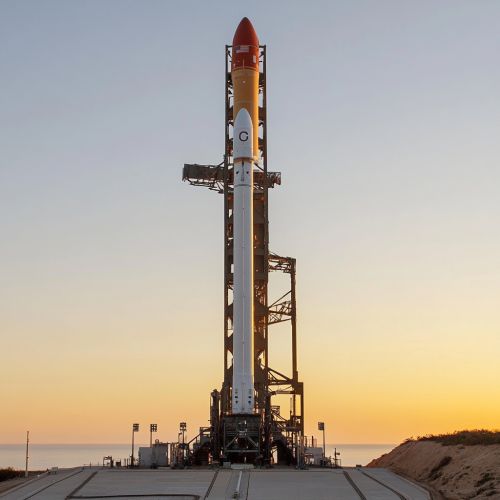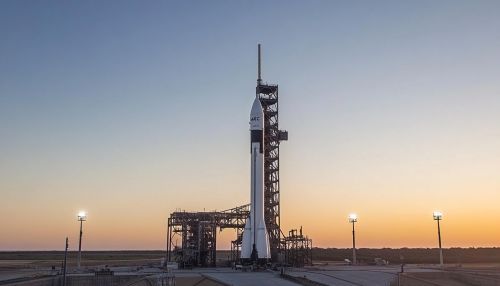Jupiter-C: Difference between revisions
(Created page with "== Introduction == The Jupiter-C was an American rocket developed in the 1950s as part of the United States' efforts to advance its space exploration capabilities during the early stages of the Space Race. It was a modified version of the Redstone missile, designed by the Army Ballistic Missile Agency (ABMA) under the leadership of Wernher von Braun. The Jupiter-C played a crucial role in the development of the Explorer 1, the first successfu...") |
No edit summary |
||
| Line 13: | Line 13: | ||
The rocket's structure was primarily constructed from lightweight aluminum alloys, designed to withstand the intense forces and temperatures experienced during launch and flight. The Jupiter-C's total length was approximately 21 meters, with a diameter of 1.78 meters. | The rocket's structure was primarily constructed from lightweight aluminum alloys, designed to withstand the intense forces and temperatures experienced during launch and flight. The Jupiter-C's total length was approximately 21 meters, with a diameter of 1.78 meters. | ||
[[Image:Detail-98495.jpg|thumb|center|Jupiter-C rocket on launch pad, with clear sky in the background.|class=only_on_mobile]] | |||
[[Image:Detail-98496.jpg|thumb|center|Jupiter-C rocket on launch pad, with clear sky in the background.|class=only_on_desktop]] | |||
=== Propulsion System === | === Propulsion System === | ||
Latest revision as of 01:21, 18 October 2024
Introduction
The Jupiter-C was an American rocket developed in the 1950s as part of the United States' efforts to advance its space exploration capabilities during the early stages of the Space Race. It was a modified version of the Redstone missile, designed by the Army Ballistic Missile Agency (ABMA) under the leadership of Wernher von Braun. The Jupiter-C played a crucial role in the development of the Explorer 1, the first successful American satellite, marking a significant milestone in space exploration history.
Development and Design
The development of the Jupiter-C began in the mid-1950s as a response to the need for a reliable launch vehicle capable of testing re-entry vehicles for ballistic missiles. The ABMA, located at Redstone Arsenal in Huntsville, Alabama, was tasked with this project. The team, led by von Braun, sought to create a rocket that could achieve higher altitudes and velocities than existing models.
Structural Design
The Jupiter-C was a three-stage rocket, with its first stage being a modified Redstone missile. The Redstone was a single-stage, liquid-fueled rocket, originally developed as a short-range ballistic missile. For the Jupiter-C, the Redstone's engine was enhanced to provide greater thrust and longer burn time. The second and third stages consisted of clusters of solid rocket motors, which were spin-stabilized to maintain trajectory accuracy.
The rocket's structure was primarily constructed from lightweight aluminum alloys, designed to withstand the intense forces and temperatures experienced during launch and flight. The Jupiter-C's total length was approximately 21 meters, with a diameter of 1.78 meters.


Propulsion System
The propulsion system of the Jupiter-C was a critical component of its design. The first stage utilized a Redstone A-7 engine, which burned a mixture of liquid oxygen and hydyne, a combination of unsymmetrical dimethylhydrazine and diethylenetriamine. This fuel mixture provided a higher specific impulse than the standard Redstone fuel, allowing the Jupiter-C to achieve greater velocity.
The second and third stages were powered by clusters of Sergeant solid rocket motors. These motors were arranged in a ring around the central axis of the rocket, with each stage igniting sequentially as the previous stage burned out. The solid rocket motors were chosen for their simplicity, reliability, and ability to produce high thrust in a compact form.
Launch History
The Jupiter-C had a total of four launches between 1956 and 1958, each serving a different purpose in the development of American space technology.
First Launch: September 20, 1956
The first launch of the Jupiter-C took place on September 20, 1956, from Cape Canaveral Air Force Station. This mission, designated RS-27, was primarily a test of the rocket's performance and the re-entry vehicle's heat shield. The launch was successful, with the rocket reaching an altitude of 1,100 kilometers and a range of 5,300 kilometers.
Second Launch: May 15, 1957
The second launch, RS-34, occurred on May 15, 1957. This mission aimed to further test the re-entry vehicle's capabilities and gather data on atmospheric re-entry conditions. The launch was again successful, providing valuable data for the development of future ballistic missile systems.
Third Launch: August 8, 1957
The third launch, RS-40, took place on August 8, 1957. This mission tested a new ablative heat shield material designed to withstand the intense heat of re-entry. The launch was successful, with the re-entry vehicle surviving the test and providing critical data for future designs.
Fourth Launch: January 31, 1958
The fourth and most significant launch of the Jupiter-C occurred on January 31, 1958. This mission, designated RS-29, was the launch of Explorer 1, the first successful American satellite. The Jupiter-C successfully placed Explorer 1 into orbit, marking a major achievement for the United States in the Space Race. This launch provided the first scientific data on the Van Allen radiation belts, a discovery that significantly advanced the understanding of Earth's magnetosphere.
Scientific Contributions
The Jupiter-C's successful launch of Explorer 1 had profound scientific implications. The satellite carried a cosmic ray detector designed by Dr. James Van Allen, which led to the discovery of the Van Allen radiation belts. These belts are regions of charged particles trapped by Earth's magnetic field, and their discovery was a pivotal moment in space science, providing insights into the behavior of charged particles in space and their impact on satellite operations.
The data collected by Explorer 1 also contributed to the understanding of the ionosphere, a region of Earth's upper atmosphere that plays a crucial role in radio wave propagation. The satellite's instruments measured variations in cosmic ray intensity, which helped scientists study the interaction between solar radiation and the ionosphere.
Legacy and Impact
The Jupiter-C's role in launching Explorer 1 established the United States as a formidable player in the Space Race, demonstrating its capability to develop and deploy advanced space technology. The success of the Jupiter-C and Explorer 1 provided a significant morale boost to the American public and scientific community, which had been lagging behind the Soviet Union following the launch of Sputnik 1.
The technological advancements achieved through the Jupiter-C program laid the groundwork for future American launch vehicles, including the Saturn I and Saturn V rockets, which would later enable the Apollo program and the first human landing on the Moon.
